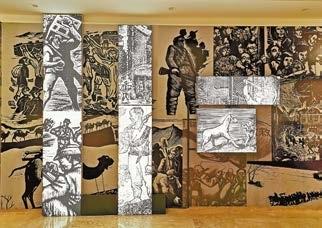

Cao Zhen caozhen0806@126.com THE “Woodcut Memories: Visual Practices and Media Communication of Chinese Artists (1931-1945)” exhibition at He Xiangning Art Museum showcases not only remarkable woodcut prints created during wartime but also old books, magazines, replicas of wartime newspapers, and film clips. Together, they weave a vivid narrative of China’s turbulent past — from awakening and transformation to resistance, struggle, and resurgence. This exhibition commemorates the 80th anniversary of the victory in the Chinese People’s War of Resistance Against Japanese Aggression and the World Anti-Fascist War, as well as the centenary of the passing of revolutionaries Sun Yat-sen and Liao Zhongkai. It is a collaborative effort among He Xiangning Art Museum, Guangdong Museum of Art, Zhejiang Museum of Art, China Guanlan Printmaking Art Museum, Lianyungang Museum, Zhuhai Gu Yuan Art Museum, and Ningbo Huamao Art Education Museum. Featuring around 200 precious woodcut works, the exhibition presents masterpieces by numerous artists, including Käthe Kollwitz, Luo Gongliu, Zhao Yannian, Song Bingheng, Liqun, Chen Wang, Gu Yuan, Huang Xinbo, Li Hua, Yan Han, Fu Luofei, and Chen Yanqiao. Through powerful lines and evocative imagery, these prints form an unforgettable tapestry depicting Chinese resilience against the Japanese invasion. Several installations decorated with replicas of wartime newspapers — printed with caricatures and woodcut prints—further highlight the significant role of visual media in spreading ideas during the war. “In the 1930s and 1940s, during a time of national crisis, woodcut print art became a ‘weapon’ due to its unique artistic language and powerful reach. Artists wielded woodcut knives like ‘guns’ and woodblocks as ‘battlefields,’ creating works that defined an era. Their wartime art constructed a grand narrative of national salvation. The images of Chinese people portrayed in these works are not only vivid artistic representations but also sources and symbols of the era’s spirit of ‘salvation,’” said Cai Xianliang, director of He Xiangning Art Museum. Dates: Through Sept. 20 Venue: He Xiangning Art Museum, Nanshan District (何香凝美术馆) Metro: Line 1 to OCT Station (华侨城站), Exit C | 
